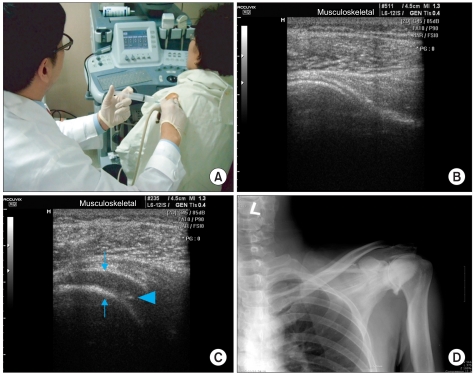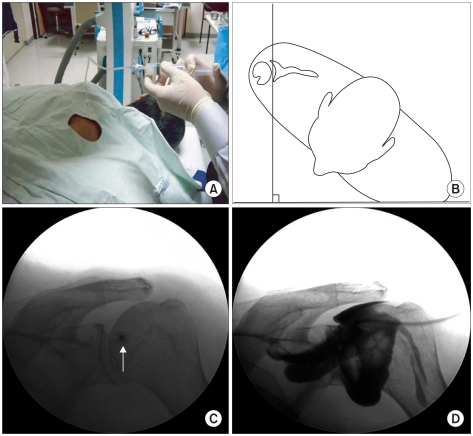Ann Rehabil Med.
2012 Feb;36(1):88-97. 10.5535/arm.2012.36.1.88.
Comparison of Sono-guided Capsular Distension with Fluoroscopically Capsular Distension in Adhesive Capsulitis of Shoulder
- Affiliations
-
- 1Department of Rehabilitation Medicine, Gachon University of Medicine and Science, Gil Medical Center, Incheon 405-760, Korea.
- 2Department of Rehabilitation Medicine, Hallym University College of Medicine, Seoul 134-701, Korea.
- 3Department of Rehabilitation Medicine, Hanyang University College of Medicine, Seoul 133-791, Korea.
- 4Department of Rehabilitation Medicine, Sanggye Paik Hospital, Inje University College of Medicine, Seoul 139-707, Korea. swc328@naver.com
- KMID: 2266785
- DOI: http://doi.org/10.5535/arm.2012.36.1.88
Abstract
OBJECTIVE
To investigate the short-term effects and advantages of sono-guided capsular distension, compared with fluoroscopically guided capsular distension in adhesive capsulitis of shoulder. METHOD: In this prospective, randomized, and controlled trial, 23 patients (group A) were given an intra-articular injection of a mixture of 0.5% lidocaine (9 ml), contrast dye (10 ml), and triamcinolone (20 mg); they received the injection once every 2 weeks, for a total of 6 weeks, under sono-guidance. Twenty-five patients (group B) were treated similarly, under fluoroscopic guidance. Instructions for the self-exercise program were given to all subjects, without physiotherapy and medication. Effects were then assessed using a visual numeric scale (VNS), and the shoulder pain and disability index (SPADI), as well as a range of shoulder motion examinations which took place at the beginning of the study and 2 and 6 weeks after the last injection. Incremental cost-effective ratio (ICER), effectiveness, preference, and procedure duration were evaluated 6 weeks post-injection.
RESULTS
The VNS, SPADI, and shoulder motion range improved 2 weeks after the last injection and continued to improve until 6 weeks, in both groups. However, no statistical differences in changes of VNS, SPADI, ROM, and effectiveness were found between these groups. Patients preferred sono-guided capsular distension to fluoroscopically guided capsular distension due to differences in radiation hazards and positional convenience. Procedure time was shorter for sono-guided capsular distension than for fluoroscopically guided capsular distension.
CONCLUSION
Sono-guided capsular distension has comparable effects with fluoroscopically guided capsular distension for treatment of adhesive capsulitis of the shoulder. Sono-guided capsular distension can be substituted for fluoroscopic capsular distension and can be advantageous from the viewpoint of radiation hazard mitigation, time, cost-effectiveness and convenience.
MeSH Terms
Figure
Cited by 2 articles
-
Randomized Controlled Trial for Efficacy of Capsular Distension for Adhesive Capsulitis: Fluoroscopy-Guided Anterior Versus Ultrasonography-Guided Posterolateral Approach
Jae Hyun Bae, Young Sook Park, Hyun Jung Chang, Min Jung Kim, Kang Young Park, Seung Hwan Jin, Eun Hee Lee
Ann Rehabil Med. 2014;38(3):360-368. doi: 10.5535/arm.2014.38.3.360.Usefulness of a Hanging Position With Internal Rotation of Shoulder in Ultrasonography-Guided Intra-articular Steroid Injection for Adhesive Capsulitis
Chang Han Lee, Hyung Seok Nam, Shi-Uk Lee
Ann Rehabil Med. 2016;40(3):520-527. doi: 10.5535/arm.2016.40.3.520.
Reference
-
1. Binder AI, Bulgen DY, Hazleman BL, Roberts S. Frozen shoulder: a long-term prospective study. Ann Rheum Dis. 1984; 43:361–364. PMID: 6742896.
Article2. Neviaser TJ. Arthroscopy of the shoulder. Orthop Clin North Am. 1987; 18:361–372. PMID: 3441361.
Article3. Andersen NH, Søjbjerg JO, Johannsen HV, Sneppen O. Frozen shoulder: arthroscopy and manipulation under general anesthesia and early passive motion. J Shoulder Elbow Surg. 1998; 7:218–222. PMID: 9658345.
Article4. Murnaghan JP. Adhesive capsulitis of the shoulder: current concepts and treatment. Orthopedics. 1988; 11:153–158. PMID: 3281152.
Article5. Gam AN, Schydlowsky P, Rossel I, Remvig L, Jensen EM. Treatment of "frozen shoulder" with distension and glucorticoid compared with glucorticoid alone. A randomised controlled trial. Scand J Rheumatol. 1998; 27:425–443. PMID: 9855212.6. Rizk TE, Gavant ML, Pinals RS. Treatment of adhesive capsulitis (frozen shoulder) with arthrographic capsular distension and rupture. Arch Phys Med Rehabil. 1994; 75:803–807. PMID: 8024429.
Article7. Vad VB, Sakalkale D, Warren RF. The role of capsular distention in adhesi ve capsulitis. Arch Phys Med Rehabil. 2003; 84:1290–1292. PMID: 13680563.8. Fareed DO, Gallivan WR Jr. Office management of frozen shoulder syndrome. Treatment with hydraulic distension under local anesthesia. Clin Orthop Relat Res. 1989; 242:177–118. PMID: 2706848.9. Tveita EK, Tariq R, Sesseng S, Juel NG, Bautz-Holter E. Hydrodilatation, corticosteroids and adhesive capsulitis: a randomized controlled trial. BMC Musculoskelet Disord. 2008; 9:53. PMID: 18423042.
Article10. Arslan S, Celiker R. Comparison of the efficacy of local corticosteroid injection and physical therapy for the treatment of adhesive capsulitis. Rheumatol Int. 2001; 21:20–23. PMID: 11678298.11. Calis M, Demir H, Ulker S, Kirnap M, Duygulu F, Calis HT. Is intraarticular sodium hyaluronate injection an alternative treatment in patients with adhesive capsulitis? Rheumatol Int. 2006; 26:536–540. PMID: 16091920.
Article12. Roach KE, Budiman-Mak E, Songsiridej N, Lertratanakul Y. Development of a shoulder pain and disability index. Arthritis Care Res. 1991; 4:143–149. PMID: 11188601.
Article13. Zaghi S, Heine N, Fregni F. Brain stimulation for the treatment of pain: a review of costs, clinical effects, and mechanisms of treatment for three different central neuromodulatory approaches. J Pain Manag. 2009; 2:339–352. PMID: 20585474.14. Fareed DO, Gallivan WR Jr. Office management of frozen shoulder syndrome. Treatment with hydraulic distension under local anesthesia. Clin Orthop Relat Res. 1989; 242:177–183. PMID: 2706848.15. Mclaughlin HL. On the frozen shoulder. Bull Hosp Joint Dis. 1951; 12:383–393. PMID: 14905118.16. Rodeo SA, Hannafin JA, Tom J, Warren RF, Wickiewicz TL. Immunolocalization of cytokines and their receptors in adhesive capsulitis of the shoulder. J Orthop Res. 1997; 15:427–436. PMID: 9246090.
Article17. Neviaser JS. Adhesive capsulitis of the shoulder : a study ofthe pathologic findings in periarthritis of the shoulder. J Bone Joint Surg. 1945; 27:211–222.18. de Jong BA, Dahmen R, Hogemwg JA, Marti RK. Intra-articular triamcinolone acetonide injection in patients with capsulitis of the shoulder: a comparative study of two dose regimens. Clin Rehabil. 1998; 12:211–215. PMID: 9688036.19. Bulgen DY, Binder AI, Hazleman BL, Dutton J, Roberts S. Frozen shoulder: prospective clinical study with an evaluation of three treatment regimens. Ann Rheum Dis. 1984; 43:353–360. PMID: 6742895.
Article20. Dacre JE, Beeney N, Scott DL. Injections and physiotherapy for the painful stiff shoulder. Ann Rheum Dis. 1989; 48:322–325. PMID: 2712613.
Article21. Rizk TE, Pinals RS, Talaiver AS. Corticosteroid injections in adhesive capsulitis: investigation of their value and site. Arch Phys Med Rehabil. 1991; 72:20–22. PMID: 1985618.22. Yamakado K. The targeting accuracy of subacromial injection to the shoulder: an arthrographic evaluation. Arthroscopy. 2002; 18:887–891. PMID: 12368787.
Article23. Partington PF, Broome GH. Diagnostic injection around the shoulder: hit and miss? A cadaveric study of injection accuracy. J Shoulder Elbow Surg. 1998; 7:147–115. PMID: 9593094.
Article24. Connell D, Padmanabhan R, Buchbinder R. Adhesive capsulitis: role of MR imaging in diff erential diagnosis. Eur Radiol. 2002; 12:2100–2106. PMID: 12136330.25. Van Holsbeeck MT, Introcaso JH. Ptasznik R, editor. Sonography of the shoulder. Musculoskeletal ultrasound. 2001. 2nd ed. St Louis: Mosby Inc;p. 504–505.26. Homsi C, Bordalo-Rodrigues M, da Silva JJ, Stump XM. Ultrasound in adhesive capsulitis of the shoulder: is assessment of the coracohumeral ligament a valuable diagnostic tool? Skeletal Radiol. 2006; 35:673–678. PMID: 16724200.
Article
- Full Text Links
- Actions
-
Cited
- CITED
-
- Close
- Share
- Similar articles
-
- Comparison of Intraarticular Steroid Injection with and without Capsular Distension in Adhesive Capsulitis of the Shoulder
- The Additional Effect of Tear after Passive Exercise during Distension Arthrography in Patients with Frozen Shoulder
- Updates on the treatment of adhesive capsulitis with hydraulic distension
- Randomized Controlled Trial for Efficacy of Capsular Distension for Adhesive Capsulitis: Fluoroscopy-Guided Anterior Versus Ultrasonography-Guided Posterolateral Approach
- Diagnosis and Rehabilitation Treatment in Adhesive Capsulitis of the Shoulder



